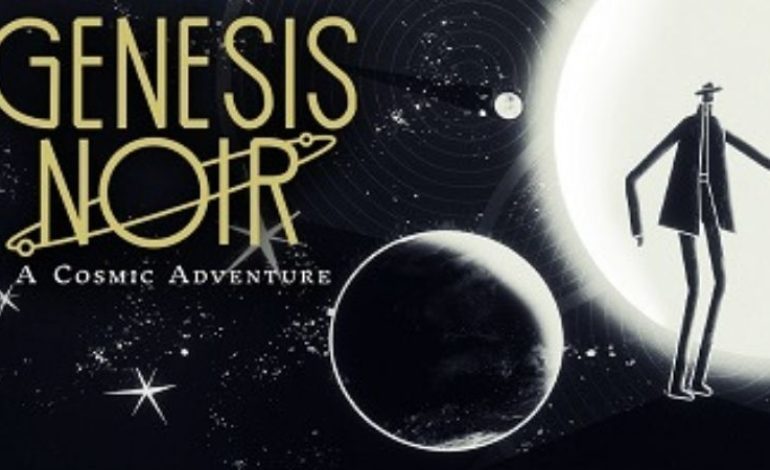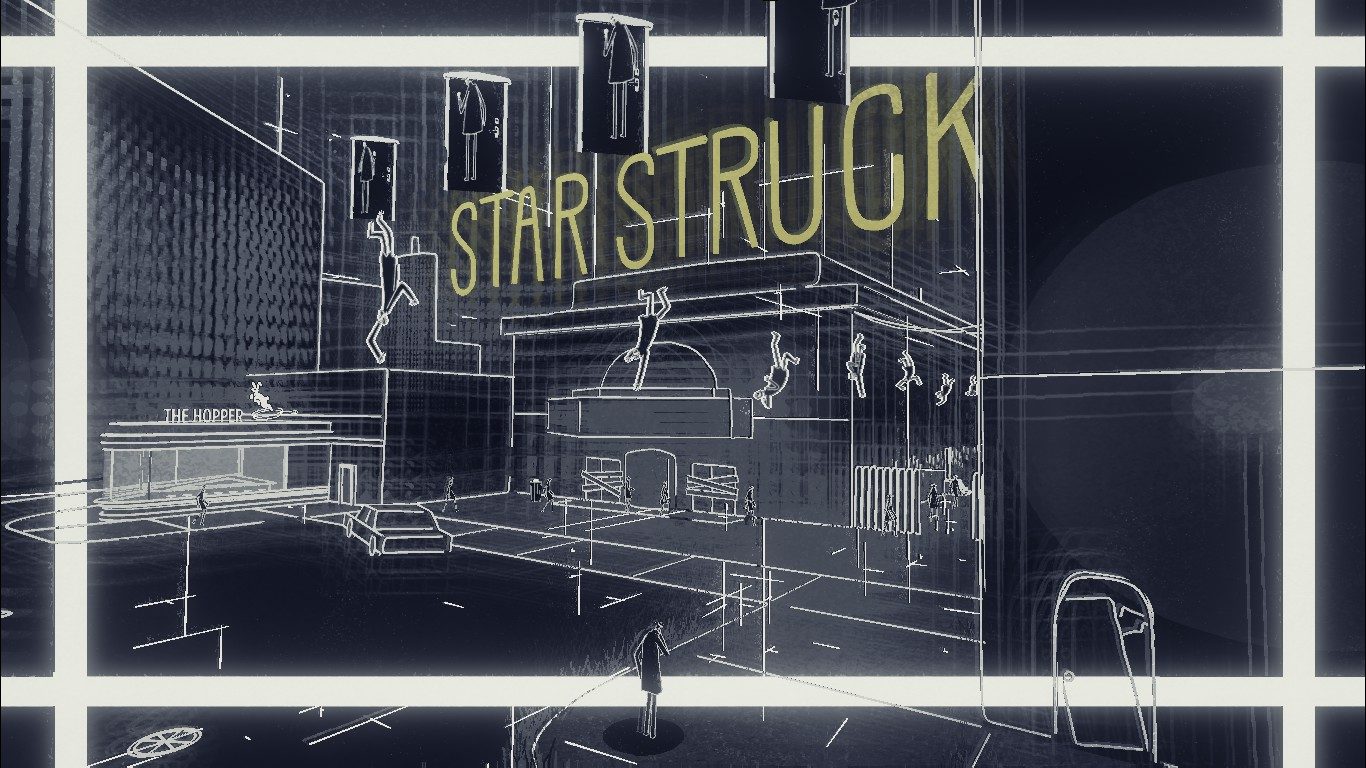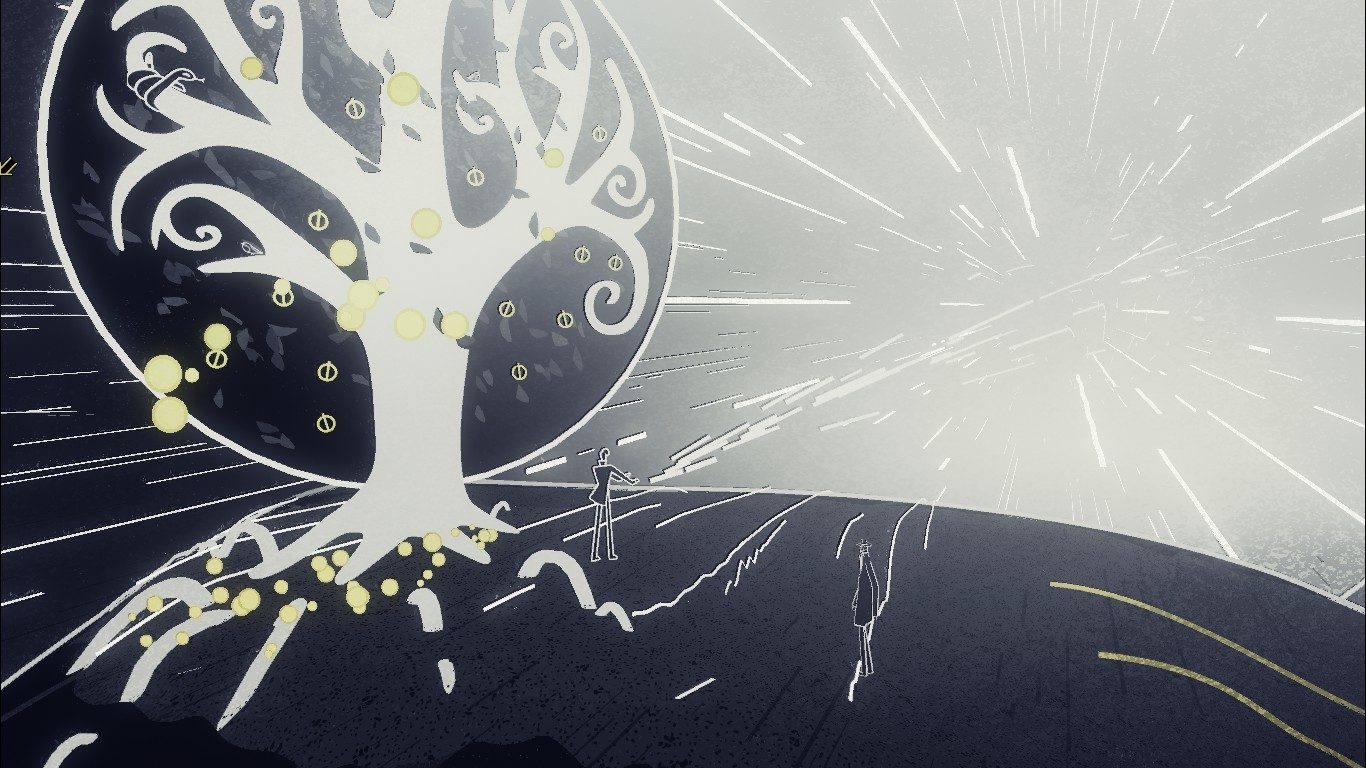

Genesis Noir is one of those games that immediately sparks curiosity upon first glance. Inspired by works such as Italo Calvino’s Cosmicomics, Genesis Noir sports a slick visual style and soundtrack that promise a compelling sensory experience. Unfortunately, while the game mostly delivers on that promise, a number of sloppy gameplay, story, and pacing issues hold it back from being an art piece truly worth treasuring.
The general premise of Genesis Noir is difficult to describe, as its concepts are largely abstract and metaphorical in nature. It involves cosmic forces that facilitate the creation of the universe, but these ideas are presented like a detective noir film. The apparent god-like being that the player controls dons the typical appearance of a man wearing a hat and trench coat, and he travels across spacetime to find clues pertaining to the Big Bang, which is represented by a disgruntled saxophone player shooting the protagonist’s lover. It’s a strange, inherently novel setup that perfectly justifies the visual aesthetic, which is mainly comprised of simple line work and an intensely monochromatic color scheme with the occasional touch of yellow to highlight important objects. It’s a striking visual style further propped up by minimalist animation that is technically limited in frame count yet brimming with expression. Accompanying the visuals is a beautifully dynamic, often jazzy soundtrack that tends to respond to small interactions with the game world. Genesis Noir constantly experiments with its aesthetic, to the point where no two scenes feel the same outside of a few intentional outliers. Moments like the improv jazz number with the friendly musician or the repeated meteor strikes are very impressive in motion, and late-game sequences play with the visuals and audio in ways that I didn’t quite expect. It’s easily the most consistently appealing aspect of the game, and even though not every sequence is a winner, it was nonetheless enjoyable to keep playing just to witness what kind of crazy scenario would happen next.


Since the game mostly focuses on its aesthetics, the gameplay mainly exists in service of those elements. Gameplay segments are, once again, minimalist in nature, with the player often performing simple tasks like popping floating bubbles or rotating the sky to make time pass by. Other reviewers have called these segments “puzzles,” but that’s not really what they are aiming to be. They are simply fun, interactive moments intended to engage the player and pull them further into the game world. For most of the campaign, this gameplay approach works fine, but there are a number of times when it falls flat. Certain sections ask the player to repeat a task several times in a row, and the unskippable cinematics and generally clunky interface ensure that this repetition never feels invisible. Rapidly clicking on a door and watching a line of cloned protagonists slowly walk through one at a time doesn’t work as the atmospheric buildup it’s clearly intended to be, and I found myself impatiently clicking to get the sequence over with.
The small bursts of interactivity are also very occasionally interrupted by a genuine attempt at puzzle design, and these moments are so out of place that they might as well be in a different game entirely. Challenging puzzles are obviously not inherently problematic, but considering how simple the rest of the game is and how unclear their rules can be at times, they end up bringing the game’s pacing to a grinding halt. In particular, the puzzle in which the player has to connect a series of glowing orbs is a frustrating, trial-and-error nightmare that often did not respond properly to my button presses, and I genuinely do not know if I was just stumped during my first few attempts at it or if a bug prevented me from progressing. In fact, the game is disappointingly buggy in general, as there were a few instances in which neither my button presses nor my mouse clicks worked as intended, forcing me to pause and unpause the game to fix the issue.


In addition to the lackluster design choices, it’s difficult to walk away from the experience and feel like the story is anywhere near as clever or impactful as it wants to be. The vagueness of the narrative permits players to interpret any number of meanings from the events that transpire, and while that storytelling approach is admirable, its exploration of the universe’s origin ultimately feels skin-deep. The overly verbose nature of the game’s prose quickly grows tiring, and the narrative’s cosmic scope ends up distracting from the most compelling narrative beats. The game hints at a backstory for the aforementioned sax player, and piecing together environmental and textual clues to figure out his connection with the protagonist and his lover feels wonderfully harmonious with the noir motif. But most of the game’s chapters have nothing to do with this core dynamic, and the narrative instead devotes a disproportionate amount of time to a number of side characters the protagonist meets throughout the campaign. It’s clear the developers intended these characters to have some deeper meaning, but they feel so incongruous with the core conflict that I kept wondering why I should even care about them at all. In general, despite the campaign only lasting more than four hours, the game weirdly felt too long, as it kept dwelling on concepts that I simply had no interest in. And after all that meandering, the game forgoes its subtle storytelling and directly states one of its core messages through dialogue, which is an underwhelming payoff, to say the least.


In many ways, Genesis Noir is a frustrating work, as it has the ingredients of a truly special game, but doesn’t mix them as well as it could have. The game deserves to be commended for its originality, and it’s still ultimately a positive experience despite its issues. It’s just unfortunate that it ended with a whimper, when it could have gone out with a bang.
Score: 6 out of 10
Reviewed on Windows 10 PC
Play games, take surveys and take advantage of special offers to help support mxdwn.
Every dollar helps keep the content you love coming every single day.
